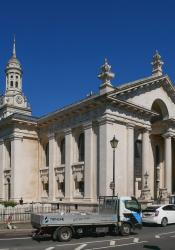The Construction of St Alfege Church
During the Viking raids in England, one of the key positions that they would land on was in Greenwich. The army of the Danish was planted in Greenwich of well over 3 years and used it as a key position in raiding places like Kent and Canterbury. While raiding the British in Canterbury, the Vikings were able to capture Archbishop Alhpege and hold him for ransom against the nobility of England. However, Alphege refused to have his bounty paid and he was butchered by the Danish for his acts against them. Alphege became a martyr and was given sainthood in April of 1012. Many years later, the influence of the Catholics died down with the Protestant Reformation and several attacks against the Catholics in England. Before the death of Queen Anne in 1814, she passed a series of Acts that allowed for the construction of several Catholic churches and subsequently the Church of St. Alfege (Daniell). During the reign of Queen Anne and on, there was a certain level of Catholic influence that was present in the communities. Despite the history of London having a strong Protestant influence, the Queen Anne Acts proved that there was a sect of Catholics still in London as of the 18th century. Additionally, the church was built by Nicholas Hawksmoor by 1714, but it wouldn’t be consecrated until 1718. The church has the typical construction of most churches in England, but the rich history of the area and the name of the church is what make it unique. The church was even used during WWII as a bomb shelter that helped defend those in air raids. The church suffered internal damages from the bombing raids but still stands to this day. As of 1982, the church is no longer used for services and stands as a historical monument.
Sources:
Daniell, Alfred Ernest, and Alexander Ansted. London Riverside Churches ... with 84 Illustrations by Alexander Ansted. Archibald Constable & Co., 1897.
Ross, David. “Canterbury, St Alphege Church - History, Travel, and Accommodation Information.” Britain Express, https://www.britainexpress.com/attractions.htm?attraction=3372.

